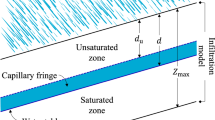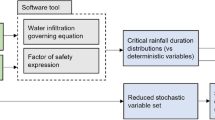Abstract
By integrating hydrological modeling with the infinite slope stability analysis, a rainfall-triggered shallow landslide model was developed by Iverson (Water Resour Res 36:1897-1910, 2000). In Iverson’s model, the infiltration capacity is assumed to be equivalent to the saturated hydraulic conductivity for finding pressure heads analytically. However, for general infiltration process, the infiltration capacity should vary with time during the period of rain, and the infiltration rate is significantly related to the variable infiltration capacity. To avoid the unrealistically high pressure heads, Iverson employed the beta-line correction by specifying that the simulated pressure heads cannot exceed those given by the beta line. In this study, the suitability of constant infiltration capacity together with the beta-line correction for hydrological modeling and landslide modeling of hillslope subjected to a rainfall is examined. By amending the boundary condition at ground surface of hillslope in Iverson’s model, the modified Iverson’s model with considering general infiltration process is developed to conduct this examination. The results show that the unrealistically high pressure heads from Iverson’s model occur due to the overestimation of infiltration rate induced from the assumption that the infiltration capacity is identical to the saturated hydraulic conductivity. Considering with the general infiltration process, the modified Iverson’s model gives acceptable results. In addition, even though the beta-line correction is applied, the Iverson’s model still produces greater simulated pressure heads and overestimates soil failure potential as compared with the modified Iverson’s model. Therefore, for assessing rainfall-triggered shallow landslide, the use of constant infiltration capacity together with the beta-line correction needs to be replaced by the consideration of general infiltration process.








Similar content being viewed by others
Abbreviations
- C :
-
The change in volumetric water content per unit change in pressure head
- C 0 :
-
The minimum value of C
- c :
-
Soil cohesion
- D 0 :
-
Ksat/C0
- d Z :
-
Water depth
- d LZ :
-
Slope depth
- FS:
-
Factor of safety
- I Z :
-
Rainfall intensity
- KL and K Z :
-
The hydraulic conductivities in the lateral and slope-normal directions
- K sat :
-
Saturated hydraulic conductivity
- T :
-
Rainfall duration
- x,y,z, and Z:
-
The coordinates
- ψ:
-
Groundwater pressure head
- θ:
-
Soil volumetric water content
- α:
-
Slope angle
- φ:
-
Soil friction angle
- γsat and γw :
-
The unit weights of saturated soil and water
- ΔZ :
-
Grid size
- Δt :
-
Time step
- i :
-
Z directional computational point index
- NX:
-
Grid point at slope base
- n :
-
Time step index
- NT:
-
Time level at end of simulation
References
Baum RL, Savage WZ, Godt JW (2002) TRIGRS-a Fortran program for transient rainfall infiltration and grid-based regional slope-stability analysis, Virginia, US Geological Survey Open file report 02–424
Bear J (1972) Dynamics of fluids in porous media, Dover. Mineola, New York
Borga M, Fontana GD, De Ros D, Marchi L (1998) Shallow landslide hazard assessment using a physically based model and digital elevation data. Environ Geol 35:81–88
Chow VT, Maidment DR, Mays LW (1988) Applied hydrology. Mcgraw-Hill, Singapore
Collins BD, Znidarcic D (2004) Stability analyses of rainfall induced landslides. J Geotech Geoenviron Eng 130(4):362–372
Crosta GB, Frattini P (2003) Distributed modeling of shallow landslides triggered by intense rainfall. Nat Hazards Earth Syst Sci 3:81–93
D’Odorico P, Fagherazzi S, Rigon R (2005) Potential for landsliding : Dependence on hyetograph characteristics. J Geophys Res Earth Surface 110(F1)
Frattini P, Crosta GB, Fusi N, Negro PD (2004) Shallow landslides in pyroclastic soil : a distributed modeling approach for hazard assessment. Eng Geol 73:277–295
Freeze RA, Cherry JA (1979) Groundwater. Prentice Hall, Englewood Cliffs
Gersho PM, Sani RL (1998) Incompressible flow and the finite-element method. Wiely, Chichester
Guadagno FM, Martion S, Scarascia Muguozza G (2003) Influence of man-made cuts on the stability of pyroclastic covers (Campania, Southern Italy) a numerical modeling approach. Environ Geol 43:371–384
Hsu SH, Ni CF, Hung PF (2002) Assessment of three infiltration formulas based on model fitting on Richards’ equation. J Hydrol Eng 7(5):373–379
Hurley DG, Pantelis G (1985) Unsaturated and saturated flow through a thin porous layer on a hillslope. Water Resour Res 21:821–824
Iverson RM (2000) Landslide triggering by rain infiltration. Water Resour Res 36:1897–1910
Keim RF, Skaugset AE (2003) Modelling effects of forest canopies on slope stability. Hydrol Process 17:1457–1467
Lan HX, Lee CF, Zhou CH, Martin CD (2005) Dynamic characteristics analysis of shallow landslides in response to rainfall event using GIS. Environ Geol 47:254–267
Montgomery DR, Dietrich WE (1994) A physically based model for the topographic control on shallow landslide. Water Resour Res 30:83–92
Morrissey MM, Wieczorek GF, Morgan BA (2001) A comparative analysis of hazard models for predicting debris flows in Madison County, Virginia. US Geological Survey Open file report 01–67
Richards LA (1931) Capillary conduction of liquids in porous mediums. Physics 1:318–333
Tsai T L, Yang JC, Huang LH (2002) Hybrid finite-difference for solving the dispersion equation. J Hydraulic Eng 128(1):78–86
Wallach R, Grigorin G, Rivlin J (1997) The errors in surface runoff prediction by neglecting the relationship between infiltration rate and overland flow depth. J Hydrol 200:243–259
Wu W, Slide RC (1995) A distributed slope stability model for steep forested basins. Water Resour Res 31:2097–2110
Author information
Authors and Affiliations
Corresponding author
Rights and permissions
About this article
Cite this article
Tsai, TL., Yang, JC. Modeling of rainfall-triggered shallow landslide. Environ Geol 50, 525–534 (2006). https://doi.org/10.1007/s00254-006-0229-x
Received:
Accepted:
Published:
Issue Date:
DOI: https://doi.org/10.1007/s00254-006-0229-x




